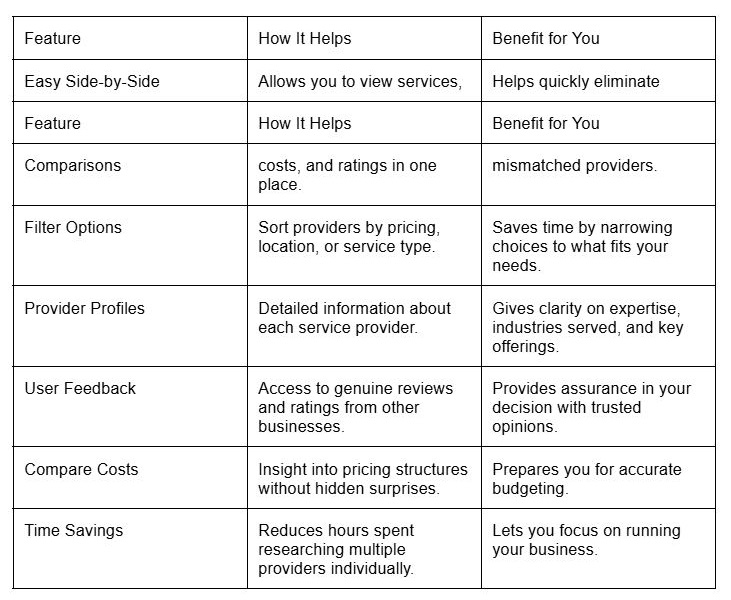
Struggling to find the right IT support can feel like looking for a needle in a haystack. With so many providers, how do you know which one truly meets your business needs? It’s easy to waste time and money searching without clear guidance.
Here’s a fact: businesses that rely on tools like a Managed IT Services & IT Support Services Directory often make faster, smarter decisions. These directories simplify your search by offering reliable options all in one place.
This guide will help you understand how these directories work and why they’re beneficial. Stick around—you’ll discover exactly what to look for next!
Here’s a fact: businesses that rely on tools like a Managed IT Services & IT Support Services Directory often make faster, smarter decisions. These directories simplify your search by offering reliable options all in one place.
This guide will help you understand how these directories work and why they’re beneficial. Stick around—you’ll discover exactly what to look for next!
What Are Managed IT and IT Support Services?

Managed IT services manage a business's technology needs. These services include network monitoring, cybersecurity, cloud management, and data backups. Providers take responsibility for maintaining systems so companies can concentrate on their core operations.
Managed IT works on a subscription model, offering predictable costs and regular support.
IT support services address tech issues when they occur. This includes troubleshooting hardware problems or resolving software errors. Support teams help with tasks like email setup or server maintenance.
Many businesses depend on these professionals to reduce downtime and ensure workflows operate efficiently.
Finding the right IT service shouldn't feel like hunting for a needle in a haystack. A managed IT directory narrows the search, saving you time and effort.
Simplified Provider Comparison
Simplifying the comparison process for IT service providers saves time, reduces stress, and makes decision-making much easier. Here's how a directory can help:
Managed IT works on a subscription model, offering predictable costs and regular support.
IT support services address tech issues when they occur. This includes troubleshooting hardware problems or resolving software errors. Support teams help with tasks like email setup or server maintenance.
Many businesses depend on these professionals to reduce downtime and ensure workflows operate efficiently.
Benefits of Using a Managed IT Services Directory
Finding the right IT service shouldn't feel like hunting for a needle in a haystack. A managed IT directory narrows the search, saving you time and effort.
Simplified Provider Comparison
Simplifying the comparison process for IT service providers saves time, reduces stress, and makes decision-making much easier. Here's how a directory can help:

This structure organizes the work into smaller, more manageable steps. It’s like having a quick reference guide for picking the best match.
Access to Verified Reviews and Ratings
Verified reviews provide honest feedback from real clients. These insights help business owners make well-informed decisions when selecting managed IT services. Relying on such ratings reduces guesswork and mitigates risks.
Ratings offer a quick overview of provider performance. High scores often indicate reliability, strong expertise, and dependable service quality. Reviews also emphasize strengths or issues that may not be apparent during initial research.
Tailored Solutions for Specific Needs
Businesses face distinctive challenges that call for customized IT support. A managed IT services directory assists in connecting providers with the appropriate expertise to address those needs.
For instance, healthcare companies can locate specialists in HIPAA-compliant solutions, while retail businesses might look for e-commerce security professionals.
These directories organize providers by industry and service type, streamlining the process for decision-makers. Business owners no longer need to sort through irrelevant choices or take risks with unfamiliar vendors.
This focused method guarantees every business receives precisely what it requires without unnecessary difficulty.
A great IT services directory helps you save time and reduce stress by providing resources to identify top providers quickly—keep reading to learn why this is important.
Comprehensive Provider Listings
Provider directories organize IT companies in one place. These lists assist businesses in finding suitable managed IT services efficiently. They usually feature company names, specialties, locations, and pricing information.
Businesses can evaluate multiple providers simultaneously. This enables owners to easily pinpoint service options that align with their requirements. With comprehensive information readily accessible, decision-making becomes quicker and more precise.
Advanced Filtering Options
Filter by industry, location, or service type to refine options efficiently. Enhanced filtering assists in finding managed IT services that align with your business requirements without excessive scrolling.
Organize providers by customer ratings or response times for more targeted results. These tools save time and help businesses connect with IT support more quickly. Now let’s explore solutions customized for specific industries!
Industry-Specific Solutions
Many IT service directories offer providers focused on industries like healthcare, finance, or retail. For example, a medical practice might need HIPAA-compliant solutions, while financial firms often require strict cybersecurity measures.
Finding providers with direct experience in your field can save time and reduce risks. These professionals understand industry standards and implement systems that meet specific regulatory requirements.
Understand what your business truly needs before diving into options. Look for providers who walk the talk with proven results and satisfied clients.
Assess Your Business Needs
Outline your current challenges. Define what aspects of your IT infrastructure require improvements. Identify whether you need help desk assistance, cloud services, cybersecurity, or network management.
Rank these needs based on their importance to daily operations.
Break down your budget. Determine how much funding is available for managed IT services. If you're considering financial support to invest further in technology improvements, explore more from Credibly for flexible funding solutions. Decide if you’ll need full-time services or occasional support for specific projects. Match this with providers who align with both your financial constraints and business objectives.
Evaluate Expertise and Client Reviews
Identifying expertise helps refine the search for the right managed IT service provider. Check their certifications, years of experience, and
industries they’ve worked with. A provider knowledgeable in your field understands your challenges better.
Client reviews provide insights into real-world experiences. Look for consistent feedback about responsiveness or problem-solving skills. Avoid providers with repeated negative reviews about downtime or poor communication.
Finding the right managed IT services shouldn’t feel like chasing smoke. A good directory saves time, energy, and headaches. Pick wisely, and your business will thank you later. Choose tools that align with your goals and make life easier.
Now you're ready to take action!
Access to Verified Reviews and Ratings
Verified reviews provide honest feedback from real clients. These insights help business owners make well-informed decisions when selecting managed IT services. Relying on such ratings reduces guesswork and mitigates risks.
Ratings offer a quick overview of provider performance. High scores often indicate reliability, strong expertise, and dependable service quality. Reviews also emphasize strengths or issues that may not be apparent during initial research.
Tailored Solutions for Specific Needs
Businesses face distinctive challenges that call for customized IT support. A managed IT services directory assists in connecting providers with the appropriate expertise to address those needs.
For instance, healthcare companies can locate specialists in HIPAA-compliant solutions, while retail businesses might look for e-commerce security professionals.
These directories organize providers by industry and service type, streamlining the process for decision-makers. Business owners no longer need to sort through irrelevant choices or take risks with unfamiliar vendors.
This focused method guarantees every business receives precisely what it requires without unnecessary difficulty.
Top Features to Look for in an IT Services Directory
A great IT services directory helps you save time and reduce stress by providing resources to identify top providers quickly—keep reading to learn why this is important.
Comprehensive Provider Listings
Provider directories organize IT companies in one place. These lists assist businesses in finding suitable managed IT services efficiently. They usually feature company names, specialties, locations, and pricing information.
Businesses can evaluate multiple providers simultaneously. This enables owners to easily pinpoint service options that align with their requirements. With comprehensive information readily accessible, decision-making becomes quicker and more precise.
Advanced Filtering Options
Filter by industry, location, or service type to refine options efficiently. Enhanced filtering assists in finding managed IT services that align with your business requirements without excessive scrolling.
Organize providers by customer ratings or response times for more targeted results. These tools save time and help businesses connect with IT support more quickly. Now let’s explore solutions customized for specific industries!
Industry-Specific Solutions
Many IT service directories offer providers focused on industries like healthcare, finance, or retail. For example, a medical practice might need HIPAA-compliant solutions, while financial firms often require strict cybersecurity measures.
Finding providers with direct experience in your field can save time and reduce risks. These professionals understand industry standards and implement systems that meet specific regulatory requirements.
How to Choose the Right Managed IT Service Provider
Understand what your business truly needs before diving into options. Look for providers who walk the talk with proven results and satisfied clients.
Assess Your Business Needs
Outline your current challenges. Define what aspects of your IT infrastructure require improvements. Identify whether you need help desk assistance, cloud services, cybersecurity, or network management.
Rank these needs based on their importance to daily operations.
Break down your budget. Determine how much funding is available for managed IT services. If you're considering financial support to invest further in technology improvements, explore more from Credibly for flexible funding solutions. Decide if you’ll need full-time services or occasional support for specific projects. Match this with providers who align with both your financial constraints and business objectives.
Evaluate Expertise and Client Reviews
Identifying expertise helps refine the search for the right managed IT service provider. Check their certifications, years of experience, and
industries they’ve worked with. A provider knowledgeable in your field understands your challenges better.
Client reviews provide insights into real-world experiences. Look for consistent feedback about responsiveness or problem-solving skills. Avoid providers with repeated negative reviews about downtime or poor communication.
Conclusion
Finding the right managed IT services shouldn’t feel like chasing smoke. A good directory saves time, energy, and headaches. Pick wisely, and your business will thank you later. Choose tools that align with your goals and make life easier.
Now you're ready to take action!

 Actus AssurTech / InsurTech
Actus AssurTech / InsurTech




